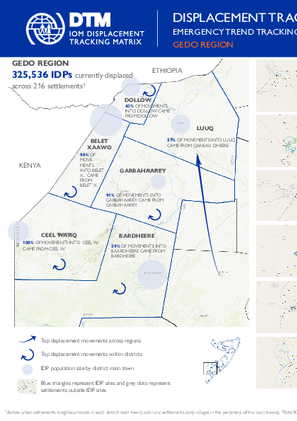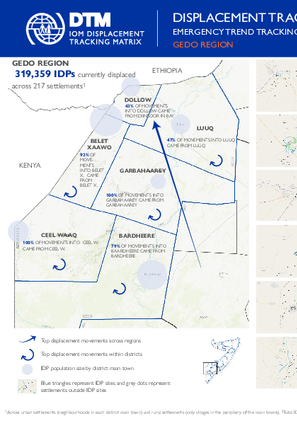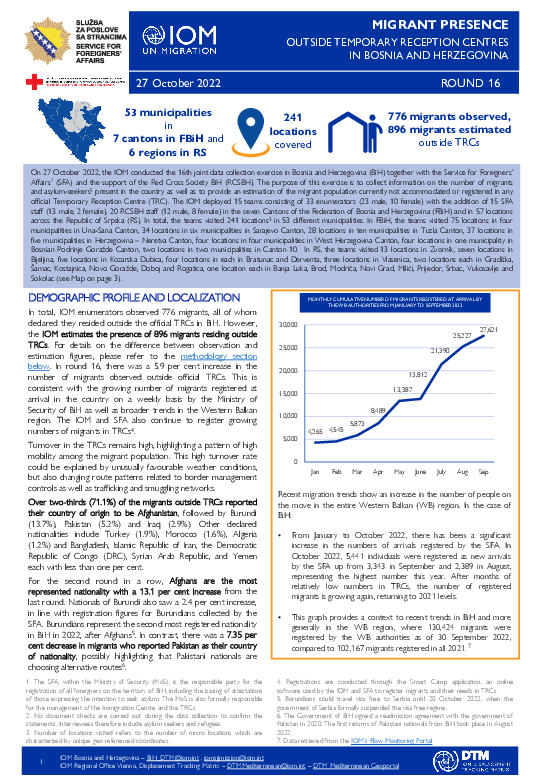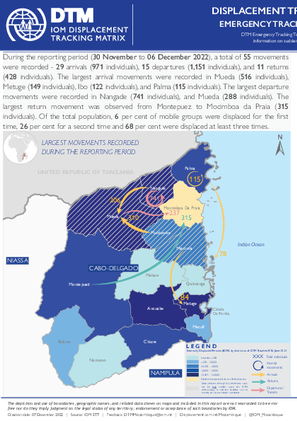-
Countries
-
Data and Analysis
-
Special Focus
-
Crisis Responses

Contact
DTM Somalia, IOMSomaliaDTM@iom.int
Language
English
Location
Somalia
Period Covered
Oct 29 2022
Nov 02 2022
Activity
- Mobility Tracking
- Event Tracking
Since November 2021, 325,888 individuals have been displaced by drought in Gedo region. Since round 34, an estimated 6,844 IDPs arrived at the assessed settlements.

Contact
DTM Somalia, IOMSomaliaDTM@iom.int
Language
English
Location
Somalia
Period Covered
Oct 22 2022
Oct 26 2022
Activity
- Mobility Tracking
- Event Tracking
Since November 2021, 319,359 individuals have been displaced by drought in Gedo region. Since round 33, an estimated 5,962 IDPs arrived at the assessed settlements.

Contact
rodakar-dataresearch@iom.int
Language
English
Location
The Gambia
Period Covered
Oct 01 2022
Oct 31 2022
Activity
- Flow Monitoring
IOM, through the Displacement Tracking Matrix (DTM) Flow Monitoring tool, collects data at key entry, exit and transit points to better understand population movements across West and Central Africa. The monitoring of population flows allows for the quantification and qualification of mobility flows and trends, migrant profiles, and migratory experiences and routes.
In The Gambia, DTM conducts Flow Monitoring activities at several important transit locations in:
1) Barra (FMPs are located at the ferry terminal and the main garage);
2) Farafenni (FMPs are located at Farafenni main garage, Farafenni Ballan-Ghar garage, Farafenni McCarthy and Sanjally garage, Farafenni turntable garage and the truck garage);
3) Basse (FMPs are situated at the main garage and the bus station in Basse Santa-Su) and
4) Brikama (FMPs are located at the main garage and the bus station).
These activities enable DTM to monitor the movements of passengers within, out of and towards The Gambia as well as the movements of those passengers transiting The Gambia. This report presents the key results of the Flow Monitoring Survey conducted from the 1st to the 31st of October 2022, excluding weekends and national holidays, with data collected for 22 days. The report presents data collected on flows, routes, departures, destinations and demographic profiles of travellers observed at the FMPs.

Contact
DTM Europe, DTMMediterranean@iom.int
Language
Bosnian, Croatian, Serbian
Location
Bosnia & Herzegovina
Snapshot Date
Oct 27 2022
Activity
- Migrants presence
- Mobility Tracking
27.10.2022. IOM u Bosni i Hercegovini (BiH) je u saradnji sa Službom za poslove sa strancima1 (SPS) i uz podršku Crvenog križa/krsta BiH (CKBiH) proveo šesnaestu zajedničku vježbu kako bi se prikupile informacije o broju migranata i tražilaca azila2 koji se trenutno nalaze u državi. Svrha ove redovne vježbe je da se pruži okvirni broj migrantske populacije koja nije smještena ili registrovana ni u jednom od privremenih prihvatnih centara (PPC) u bilo kojem trenutku.
Raspoređeno je ukupno 15 timova, sačinjenih od 33 popisivača (23 muškaraca, 10 žena), uz dodatnih 15 inspektora SPS-a (13 muškaraca, 2 žene) i 20 uposlenika CKBiH (12 muškaraca, 8 žena), u sedam kantona Federacije Bosne i Hercegovine (FBiH) i na 57 lokacija unutar entiteta Republika Srpska (RS).
Posjećena je ukupno 241 lokacija 3 u 53 različite općine. Timovi su u FBiH posjetili 75 lokacija u četiri općine Unsko-sanskog kantona (USK), 34 lokacije u šest općina Kantona Sarajevo (KS), 28 lokacija u deset općina Tuzlanskog kantona (TK), 37 lokacija u pet općina Hercegovačko-neretvanskog kantona (HNK), četiri lokacije u četiri općine Zapadno-hercegovačkog kantona (ZHK), četiri lokacije u jednoj općini Bosansko-podrinjskog Kantona-Goražde (BPK) i dvije lokacije u dvije općine u Kantonu 10. Timovi su u RS-u posjetili 13 lokacija u Zvorniku, sedam lokacija u Bijeljini, pet lokacija u Kozarskoj Dubici, po četiri lokacije u Bratuncu i Derventi, tri lokacije u Vlasenici, po dvije lokacije u Gradišci, Šamcu, Kostajnici, Novom Goraždu, Doboju i Rogatici, te po jednu
lokaciju u Banjojluci, Brodu, Novom Gradu, Milićima, Prijedoru, Srbcu, Vukosavlju i Sokocu (vidi Mapu na str.3).

Contact
DTM Europe, DTMMediterranean@iom.int
Language
English
Location
Bosnia & Herzegovina
Snapshot Date
Oct 27 2022
Activity
- Migrants presence
- Mobility Tracking
On 27 October 2022, the IOM conducted the 16th joint data collection exercise in Bosnia and Herzegovina (BiH) together with the Service for Foreigners’ Affairs1 (SFA) and the support of the Red Cross Society BiH (RCSBH). The purpose of this exercise is to collect information on the number of migrants and asylum-seekers2 present in the country as well as to provide an estimation of the migrant population currently not accommodated or registered in any official Temporary Reception Centre (TRC). The IOM deployed 15 teams consisting of 33 enumerators (23 male, 10 female) with the addition of 15 SFA staff (13 male, 2 female), 20 RCSBH staff (12 male, 8 female) in the seven Cantons of the Federation of Bosnia and Herzegovina (FBiH) and in 57 locations
across the Republic of Srpska (RS). In total, the teams visited 241 locations3 in 53 different municipalities. In FBiH, the teams visited 75 locations in four municipalities in Una-Sana Canton, 34 locations in six municipalities in Sarajevo Canton, 28 locations in ten municipalities in Tuzla Canton, 37 locations in five municipalities in Herzegovina – Neretva Canton, four locations in four municipalities in West Herzegovina Canton, four locations in one municipality in Bosnian Podrinje Goražde Canton, two locations in two municipalities in Canton 10. In RS, the teams visited 13 locations in Zvornik, seven locations in Bijeljina, five locations in Kozarska Dubica, four locations in each in Bratunac and Derventa, three locations in Vlasenica, two locations each in Gradiška,
Šamac, Kostajnica, Novo Goražde, Doboj and Rogatica, one location each in Banja Luka, Brod, Modriča, Novi Grad, Milići, Prijedor, Srbac, Vukosavlje and Sokolac (see Map on page 3).
Contact
DTM Libya, DTMLibya@iom.int
Language
English
Location
Libya
Snapshot Date
Nov 30 2022
Activity
- Mobility Tracking
- Site Assessment
Detention Centre Profiling is a component of IOM Libya’s Displacement Matrix programme. It is a data oriented tool that routinely provides specific sex and age demographic data and key sectorial information on individuals held in Libya’s detention centres on the date of assessment.

Contact
DTMMozambique@iom.int
Language
English
Location
Mozambique
Period Covered
Nov 30 2022
Dec 06 2022
Activity
- Mobility Tracking
- Event Tracking
During the reporting period (30 November to 06 December 2022), a total of 55 movements were recorded - 29 arrivals (971 individuals), 15 departures (1,151 individuals), and 11 returns (428 individuals). The largest arrival movements were recorded in Mueda (516 individuals), Metuge (149 individuals), Ibo (122 individuals), and Palma (115 individuals). The largest departure movements were recorded in Nangade (741 individuals), and Mueda (288 individuals). The largest return movement was observed from Montepuez to Mocimboa da Praia (315 individuals). Of the total population, 6 per cent of mobile groups were displaced for the first time, 26 per cent for a second time and 68 per cent were displaced at least three times.
La crise dans le Bassin du lac Tchad est le résultat d’une combinaison complexe d’une multitude de facteurs, y compris un conflit armé impliquant des groupes armés non étatiques, des niveaux extrêmes de pauvreté, un sous-développement persistant, et des bouleversements climatiques, qui ont conduit à des déplacements de populations importants. Au 30 Novembre 2022, le Cameroun, le Tchad, le Nigeria et le Niger accueillaient 6,034,686 individus affectés par la crise, dont des Personnes déplacées internes (PDI), des réfugiés et des retournés (anciennes PDI et retournés de l’étranger). 73 pour cent d’entre eux (soit 4,427,934 personnes) se trouvaient au Nigéria, 11 pour cent au Cameroun (654,136 personnes), 8 pour cent au Tchad (505,928 personnes) et 7 pour cent au Niger (446,687 personnes).
The crisis currently affecting the Lake Chad Basin states results from a complex combination of factors, including conflict with Non-State Armed Groups, extreme poverty, underdevelopment and a changing climate, which together have triggered significant displacement of populations. As of 30 November 2022, Cameroon, Chad, Niger and Nigeria were hosting an estimated 6,034,686 affected individuals made up of Internally Displaced Persons (IDPs), Refugees (both in- and out-of-camp) and Returnees (Former IDPs and Returnees from abroad). 73 per cent of the affected population (representing 4,427,934 individuals) were located in Nigeria, while 11 per cent resided in Cameroon (654,136) individuals), 8 per cent in Chad (505,928 individuals) and 7 per cent in Niger (446,687 individuals).
La région du Sahel central, et plus particulièrement la zone du Liptako Gourma, qui enjambe le Burkina Faso, le Mali et le Niger, est témoin d’une crise complexe qui comprend comme enjeux une compétition grandissante pour le contrôle de ressources; des bouleversements climatiques; une croissance démographique galopante; des niveaux élevés de pauvreté; l’absence d’opportunités économiques et un sentiment de désillusions quant au futur; des tensions communautaires; l’absence de présence étatique et le manque de services sociaux de base; et des violences provoquées par des réseaux de crime organisé et des groupes armés non étatiques. La crise a engendré, en 2021, la mort de 5 000 personnes (au 31 décembre) et conduit à des déplacements de populations significatifs dans les quatre pays touchés par la crise.
Au30 Novembre 2022, 2 411 197 individus étaient déplacés par la crise, y compris 2 175 090 Personnes déplacées internes (90% de la population affectée) et 236 107 réfugiés (10%). Soixante-six pour cent de la population déplacée (1 600 521 personnes) se trouvait au Burkina Faso, 20 pour cent au Mali (480 184), 10 pour cent au Niger (232 770) et 4 pour cent en Mauritanie (97 127).


